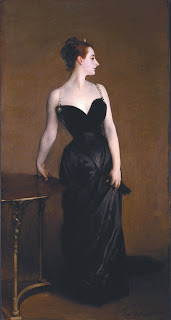by Jean Strouse
New York Review of Books
October 5, 2015
At the age of fifty-one, with his work in high demand on both sides of the Atlantic, John Singer Sargent swore off painting portraits. He had been eager for some time to escape the confines of the studio, the pressures of multiple sittings, and society portraiture altogether. “No more paughtraits,” he wrote to a friend in 1907. “I abhor and abjure them and hope never to do another especially of the Upper Classes.” He had been charging a thousand guineas a portrait “in order to have fewer to do,” he told another friend, but price did not discourage his affluent clientele.1 A Max Beerbohm cartoon shows the portly, bearded artist peering out the window of his London studio in alarm at a queue of fashionably dressed ladies, with uniformed bellhops holding places in line for more.
Sargent made exceptions to the portrait ban for friends, and for eminences such as Lord Curzon, the archbishop of Canterbury, John D. Rockefeller, and Woodrow Wilson (he turned down Pierpont Morgan). Yet for the most part, once he had slipped the silken shackles of commissions, he turned his attention to painting murals for the Boston Public Library, and to doing more of what he had loved all his life: traveling, often with artist friends, and working outdoors in natural light.
The “off-duty” paintings he did primarily for his own pleasure tend, not surprisingly, to be looser, more intimate and experimental than his formal grand-manner portraits, and about ninety of them are currently on view at New York’s Metropolitan Museum of Art in an exhibition called “Sargent: Portraits of Artists and Friends.” Organized by the National Portrait Gallery in London, where it opened last spring, and curated by Richard Ormond with Elaine Kilmurray, the coauthors of the definitive Sargent catalogue raisonné (eight volumes so far), it brings together from public and private collections a glorious selection of some of the artist’s finest work. For New York, the Met’s Elizabeth Kornhauser and Stephanie L. Herdrich have added works from the museum’s own extensive Sargent collections, including twenty-one on paper.
Sargent seems to have known everyone, and his cultural tastes ranged from Wagner and Voltaire to Javanese dancers and Charlie Chaplin. Very much in evidence here are the vitality and technical virtuosity of his work, his insistence, as Richard Ormond describes it, “on the material of paint, on the flux and instability of surface textures, on condensed forms and odd angles of perspective.” The exhibition traces the arc of Sargent’s career over geography and time. Among its abundant pleasures is a quiet sense that the paintings trace the reticent artist’s own profile through his life in art, which is where he most intensely lived.
More


